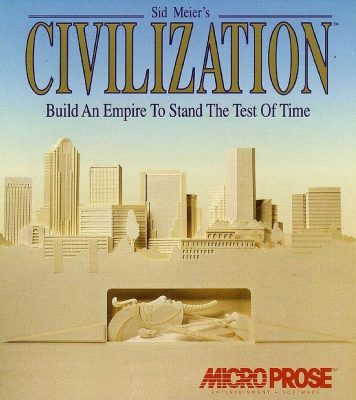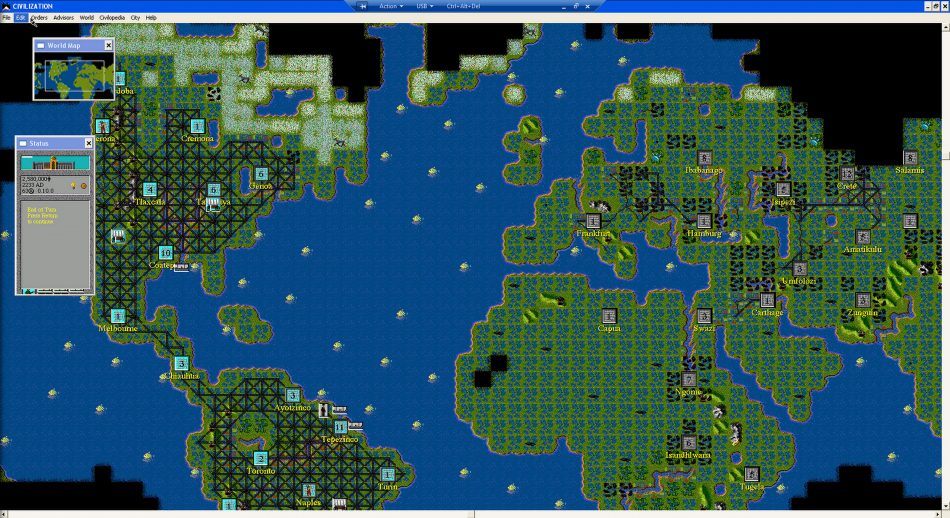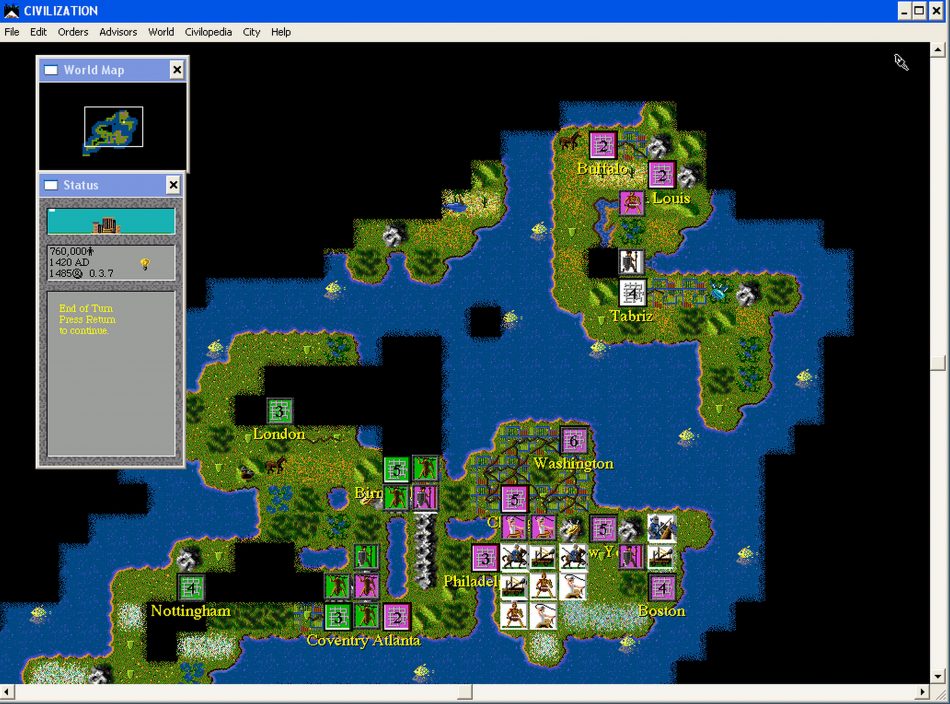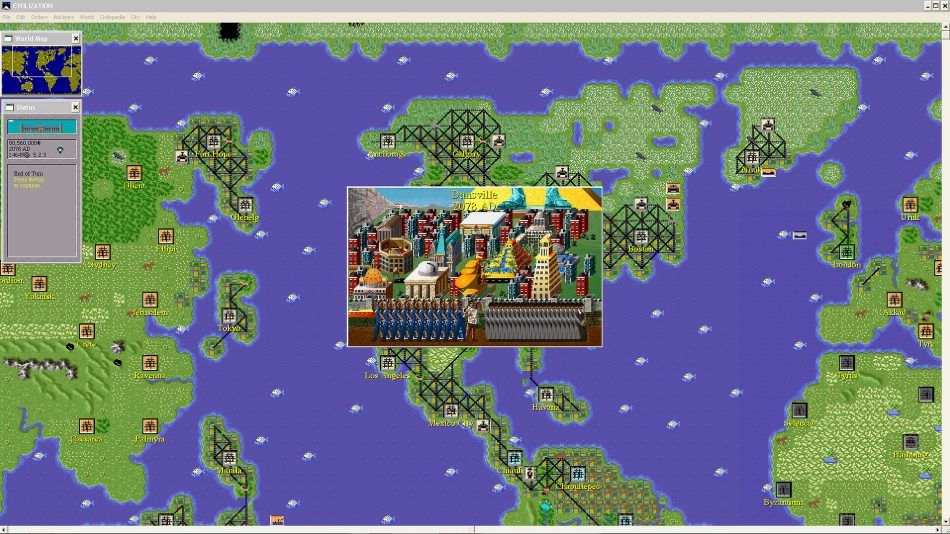Retrospective of Sid Meier’s Civilization I
 “Just…One…More…Turn…”
“Just…One…More…Turn…”
– Everyone who has played Civilization
 By Patrick S. Baker
By Patrick S. Baker
Bill Stealey and Sid Meier co-founded MicroProse in 1982 and over the next few years published several phenomenally successful flight and military simulation games, such as Spitfire Ace, Solo Flight and Red Storm Rising. Then, in 1987, the company, at Meier’s insistence, shifted into also producing highly successful strategy and adventure games such as Sid Meier’s Pirates!, Sword of the Samurai and Railroad Tycoon.
In 1990, after completing and releasing Railroad Tycoon, Meier and his protégé, Bruce Shelley turned to working, with a distinct lack of enthusiasm, on an espionage adventure game called Covert Action. At this same time, the newly married Meier was also working on another project on his own time, which would eventually become Sid Meier’s Civilization (Civ I).
Various sources report different inspirations for the game: One source says that Civ I came out of Meier’s enduring fascination with SimCity. Meier thought the “so-called software toy” was a “stunning achievement” and thought he could “gamify” it to make the experience more involving.

Another says that Civ I was, in a way, an expansion of Railroad Tycoon with Meier recalling: “…we were bold and wondered what is a bigger, more epic thing we can do? Well, how about the history of civilization? We were young, and we had no fear.”
A third asserts that the first Civilization game was at first meant to be a direct digitized version of the Avalon Hill board game, Civilization, which had reached America from the UK in 1981. Meier poured chilly water on that idea, saying in a later interview: “I had not played that (the board game) before I did Civilization. I played it later.” However, Shelley was remarkably familiar with the board game, recalling “I had played it many times…I owned the original board game, but don’t recall if I brought it into the office.”
 Meier went on to say that the board game that inspired him was actually Hasbro’s Risk. According to the game developer, “It (Civ I) was kind of like Risk brought to life on the computer.”
Meier went on to say that the board game that inspired him was actually Hasbro’s Risk. According to the game developer, “It (Civ I) was kind of like Risk brought to life on the computer.”
At about the same time as Meier and Shelley were working on Covert Action the MicroProse leadership, aside from Meier, moved the company into risky new ventures like consoles and arcade games. Meier wanted nothing to do with those kinds of projects. Plus, he was tired of having to deal with the business end of the company. So, in 1989, Stealey bought him out and Meier signed an exclusive deal with MicroProse to develop games as a contractor.
 During the two-year development of the game, Meier and Shelley fell into a singular sequence: Meier would code a working prototype of the game and give it to Shelley, who would exhaustively play test it. The two would then meet and discuss any issues. Meier would revise the game that afternoon and evening and leave the updated version for Shelley to evaluate the next day. The two would continue this “battle-rhythm” until the game was ready.
During the two-year development of the game, Meier and Shelley fell into a singular sequence: Meier would code a working prototype of the game and give it to Shelley, who would exhaustively play test it. The two would then meet and discuss any issues. Meier would revise the game that afternoon and evening and leave the updated version for Shelley to evaluate the next day. The two would continue this “battle-rhythm” until the game was ready.
The first iteration of the game was, according to Meier, “like watching paint dry.” In the prototype, the player would mark out parts of the map for agriculture, or industry, and would merely observe as the game filled in the areas in “real-time”. This was exceptionally boring.
 After Meier and Shelley finished the first prototype and it turned out to be extraordinarily dull, the two decided to backburner the game for a time. Also, Bill Stealey, despite the success of Railroad Tycoon and Pirates, did not really understand strategy and adventure games but trusted Meier enough to let him run with it. Still, Stealey insisted that Meier and Shelley finish Covert Action before going back to work on Civilization I.
After Meier and Shelley finished the first prototype and it turned out to be extraordinarily dull, the two decided to backburner the game for a time. Also, Bill Stealey, despite the success of Railroad Tycoon and Pirates, did not really understand strategy and adventure games but trusted Meier enough to let him run with it. Still, Stealey insisted that Meier and Shelley finish Covert Action before going back to work on Civilization I.
The time off from the game revitalized the pair, allowing them to make the required changes from the prototype version into what would become recognizably Civilization. First, the pair jettisoned the real-time aspect, turning it into a turned-based game where the player needed to make decisions every turn. They also added city management, scouts, settlers, and the military aspects to the game. Lastly, Meier added the famous technology tree.
 The naming of the game came late in the development cycle. The game and the name Sid Meier’s Civilization had nothing to do with the Avalon Hill game. However, MicroProse took no chances about any similarities, real or imagined, between the two games and licensed the title “Civilization” from Avalon Hill for video games for a sum of money. This postponed legal wrangling about the name for almost ten years.
The naming of the game came late in the development cycle. The game and the name Sid Meier’s Civilization had nothing to do with the Avalon Hill game. However, MicroProse took no chances about any similarities, real or imagined, between the two games and licensed the title “Civilization” from Avalon Hill for video games for a sum of money. This postponed legal wrangling about the name for almost ten years.
MicroProse released Civ I in September 1991 to no fanfare. The hostility of the MicroProse management team about Meier’s game manifested in extraordinarily little promotion or marketing of Civilization.
The reviews were incandescently glowing. The review from the December 1991 Computer Gaming World (CGW) was typical of most. The review sums up this way: “Sure to succeed beyond even Railroad Tycoon, a new Olympian in the genre of god games has truly emerged and Sid Meier’s Civilization is likely to prove itself the greatest discovery in computer entertainment since, well… the wheel!” Other reviews were equally rave and to cite more of them here would be repetitive.
 More telling as to the quality of Civ I were the awards won and the best of lists the game made even years after its initial release. The game won the Origins Award in the category “Best Military or Strategy Computer Game” of 1991. Also, CGW named the game Overall Game of the Year for 1991. In 1993 CGW put Civ I in its Game Hall of Fame. In 1994, PC Gamer US dubbed Civilization the second-best computer game of all time (second only to Doom). Also, in 1994 PC Gamer UK named the Windows version of the game the sixth-best computer game of all time. Then in 1996, the CGW editors chose Civ I as the best game of all time!
More telling as to the quality of Civ I were the awards won and the best of lists the game made even years after its initial release. The game won the Origins Award in the category “Best Military or Strategy Computer Game” of 1991. Also, CGW named the game Overall Game of the Year for 1991. In 1993 CGW put Civ I in its Game Hall of Fame. In 1994, PC Gamer US dubbed Civilization the second-best computer game of all time (second only to Doom). Also, in 1994 PC Gamer UK named the Windows version of the game the sixth-best computer game of all time. Then in 1996, the CGW editors chose Civ I as the best game of all time!
In 2000, Gamespot named Civ I as the tenth most influential video game of all time. Nor was Civilization’s recognition limited to just the gaming community. On 12 March 2007, The New York Times named Civilization as one of the ten most important games of all time. Then in 2012 Time Magazine named it one of the one hundred greatest video games of all time.
Civ I also sold very well despite little support from MircoProse. By the 1996 release of the first direct sequel Civilization II, Civ I had sold 850,000 copies. Five years later sales reached one million copies. A nice return on an investment of just $170,000 dollars. As of this writing, the first Civilization game has spawned five direct sequels and six tangential sequels.
Patrick S. Baker is a former US Army Field Artillery officer and retired Department of Defense employee. He has degrees in History, Political Science and Education. He has been writing history, game reviews, and science-fiction professionally since 2013. Some of his other works can be found at Sirius Science Fiction, Sci-Phi Journal, Armchair General, and Historynet.com.
Sources:
Computer Game World Magazine archive
Daily Worker Placement, The: Civilization Games: A Retrospective Part One
Digital Antiquarian: The Game of Everything, Part 1: Making Civilization
Gamasutra: The History of Civilization
Glixel: Civilization’ Creator Sid Meier: “I Didn’t Really Expect to be a Game Designer
Meier, Sid with Jennifer Lee Noonan, Sid Meier’s Memoir!: A Life in Computer Games (New York: W. W. Norton, Co. 2020)
New York Times (4 October 2013)
PC Gamer Online: The Complete History of Civilization
PC Gamer UK. (April 1994)
PC Gamer US Magazine (August 1994)

Oh the hours I’ve spent playing Microprose games.. F19/F117, F-15 strike eagle games, Gunship, Master of Orion, Master of Magic, Grand Prix the railroad and transport tycoon games almost cost me my first year of university 🙂
To land in the middle. Loved the Civ II game and assorted scenarios!
Civ III was the one that stole much of my time. And it still does. Great fun!